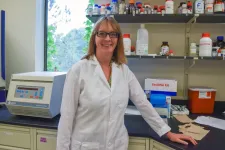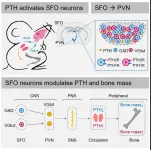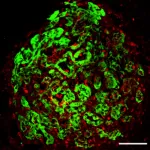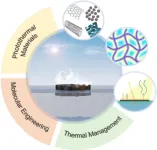(Press-News.org)
A single species invades an ecosystem causing its collapse. A cyberattack on the power system causes a major breakdown. These type of events are always on our mind, yet they rarely result in such significant consequences. So how is it that these systems are so stable and resilient that they can withstand such external disruptions? Indeed, these systems lack a central design or blueprint, and still, they exhibit exceptionally reliable functionality.
In the early 70s the field of ecology was split on the question of whether biodiversity is a good or a bad thing for an ecosystem. In 1972 Sir Robert May showed, mathematically, that an increase in biodiversity causes less ecological stability. Hence, a large ecological system cannot sustain its stable functionality beyond a certain level of biodiversity and will inevitably collapse in the face of even the smallest twitch.
May's publication not only goes against current knowledge and empirical observations of real ecosystems, but, more broadly, seems to defy everything commonly known about interaction networks in social, technological and biological systems. While May's prediction suggests that all these systems are unstable, our experience is in direct contradiction. Our biology is manifested by genetic interaction networks, our brain operates based on a complex web of neuron and synapses, our social and economic systems are driven by social networks, and our technological infrastructure, from the Internet to the power grid, are all large complex networks which actually function quite robustly.
May himself understood the shortcomings of his solution, leading him to ask “what then are nature's devious strategies to ensure the stability of complex networks?” This question, known in the field as the diversity-stability paradox, has continued to plague researchers for over five decades.
In a study published today (April 20, 2023) in the journal Nature Physics, researchers from Bar-Ilan University in Israel solve this puzzle by offering, for the first time, a fundamental answer to this lingering question.
The researchers found that the missing piece of the puzzle in May’s original formulation is that the patterns of interaction in social, biological and technological networks are highly non-random. Random networks tend to be rather homogeneous and all nodes within these networks are roughly the same. For instance, the probability of one individual having many more friends than average is tiny. Such networks may be sensitive and unstable. Real-world networks, on the other hand, are extremely diverse and heterogeneous. They include a combination of average, typically sparsely connected nodes, with ones that have many more links – hubs – that may be ten, 100 or even 1,000 times more connected than average.
When the Bar-Ilan team did the math, they found that this heterogeneity can fundamentally alter the behavior of the system. Quite surprisingly, it actually enhances stability. The analysis indicates that when a network is large and heterogeneous it acquires a guaranteed stability that is extremely robust against external forces. This clearly explains the fact that most networks around us – from the Internet to our brain -- exhibit highly resilient functionality despite enduring constant perturbations and obstructions.
"This extreme heterogeneity can be seen in almost all networks around us, from genetic networks, to social and technological networks," says Prof. Barzel, of Bar-Ilan University's Department of Mathematics and Gonda (Goldschmied) Multidisciplinary Brain Research Center, the study's lead author. "To put this in context, consider your friend on Twitter who has 10,000 followers, a thousand times the average. In everyday terms, if the average person is roughly two meters tall, such thousand-fold deviation would be tantamount to meeting a two kilometer tall individual, which is obviously impossible. But it is what we observe every day in the context of social, biological and technological networks," adds Barzel in explaining the strong link between abstract mathematical analysis and seemingly simple, everyday phenomena.
Large and heterogeneous complex networks not only can be stable, but, in fact, they often must be stable. Uncovering the rules that make a large complex system stable can offer new guidelines for tackling the pressing scientific and policymaking challenge of designing stable infrastructure networks that can not only protect against viable threats, but also strengthen the resilience of crucial, yet fragile, ecosystems.
Barzel's research team included Bar-Ilan University Prof. Simi Haber and postdoctoral researchers Dr. Chandrakala Meena, Dr. Chittaranjan Hens, and Dr. Suman Acharyya, as well as Prof. Stefano Boccaletti (CNR - Institute of Complex Systems, Florence, Italy).
END
About The Study: The findings of this study of 55,000 adult and pediatric patients hospitalized with laboratory-confirmed COVID-19 in Canada suggest that COVID-19 vaccination is important to reduce the burden on the Canadian health care system as well as severe outcomes associated with COVID-19.
Authors: Robyn Mitchell, M.H.Sc., of the Public Health Agency of Canada in Ottawa, is the corresponding author.
To access the embargoed study: Visit our For The Media website at this link https://media.jamanetwork.com/
(doi:10.1001/jamanetworkopen.2023.9050)
Editor’s ...
About The Study: In this study of 171 participants who received primary surgery and postoperative radiation for head and neck squamous cell carcinoma, lower levels of written health literacy were significantly associated with postoperative radiation delays when controlling for demographic and clinical factors. The addition of health literacy and the community-level area deprivation index improved the model’s prediction of postoperative radiation delay risk.
Authors: Tuleen Sawaf, B.S., of the University of Kansas Medical Center in Kansas City, is the corresponding author.
To access the embargoed study: Visit our For The Media website at this link https://media.jamanetwork.com/
(doi:10.1001/jamaoto.2023.0308)
Editor’s ...
Chitin (kai’tin) and healthy fats from insects appear to contribute to healthy gut microbiota and are strong sources of protein and nutrients, according to a paper co-authored by a Colorado State University researcher and published in Nature Food.
Tiffany Weir, an associate professor in CSU’s Department of Food Science and Human Nutrition, co-authored the paper with the University of Wisconsin’s Valerie Stull. They pioneered human research on cricket consumption’s effect on gut microbiota.
Weir said that her and Stull’s earlier research helped spawn Weir’s latest study of how cricket-derived chitin in designer chocolate patties may increase ...
Bones, although composing the hardest tissue in the human body, are not stagnant structures. According to recent studies, bones maintain a lively metabolism and closely interact via nerves with the brain. But whether endocrine hormones also play an important role in brain-bone talk has been unclear.
Researchers from the Shenzhen Institute of Advanced Technology (SIAT) of the Chinese Academy of Sciences now have an answer to this question. They have revealed that the subfornical organ (SFO), a brain nucleus above the third ventricle ...
Cedars-Sinai investigators are developing a novel way to treat amyotrophic lateral sclerosis (ALS) and retinitis pigmentosa using engineered stem cells that may eventually lead to personalized treatments.
The new approach uses cells derived from human induced pluripotent stem cells (iPSCs) that are renewable and scalable, and also can delay the progression of these neurodegenerative diseases in rodents.
This research, published in the journal Stem Cell Reports, marks an important first step toward achieving more personalized therapies for people with these debilitating conditions that currently have ...
New York, NY (April 20, 2023)—Researchers at the Icahn School of Medicine at Mount Sinai have demonstrated in a preclinical study a potential new therapeutic approach to treating the most common form of lung cancer.
The strategy involves inhibiting the immune-system molecule TREM2 while enhancing natural killer cells (the so-called protectors of the immune system). It was described in the April 20 online issue of Nature Immunology [DOI: 10.1038/s41590-023-01475-4] https://www.nature.com/articles/s41590-023-01475-4.
“Our study reveals that macrophages expressing the molecule TREM2 drive the depletion and dysfunction of effector ...
HOUSTON ― Vijay Goradia, a Houston-based businessman, philanthropist, and cancer survivor, has donated $10 million to The University of Texas MD Anderson Cancer Center to speed translational research and clinical trials. An initial allocation of $3.5 million will fund the institution’s clinical trial of a CD70-targeted chimeric antigen receptor (CAR) natural killer (NK) cell therapy for patients with renal cell carcinoma (RCC), developed by Katy Rezvani, M.D., Ph.D., professor of Stem Cell Transplantation and Cellular Therapy.
“We are focused on supporting the innovation ...
ANN ARBOR—The "spooky action at a distance" that once unnerved Einstein may be on its way to being as pedestrian as the gyroscopes that currently measure acceleration in smartphones.
Quantum entanglement significantly improves the precision of sensors that can be used to navigate without GPS, according to a new study in Nature Photonics.
"By exploiting entanglement, we improve both measurement sensitivity and how quickly we can make the measurement," said Zheshen Zhang, associate professor of electrical and computer engineering at the University ...
The paper is an important speech made by Min Wang, Vice Minister of the former Ministry of Land and Resources of the PRC, at the seminar “Groundwater and Healthy & Green Development”, which indicated the problems of geological and hydrogeological work over the past decades, and what should we do next. Although significant progress in geological work has been made in China, there are still many challenges need to be done, “going one step further” is very important. It is necessary to promote the transformation of geological work, ...
Freshwater is essential for human life and the scarcity of freshwater is a critical issue in parts of the world today. In recent years, scientists have put great efforts into developing desalination technologies so that clean water can be produced from seawater. Interfacial solar evaporation (ISE) is a technology that holds promise for helping to relieve worldwide freshwater shortages. A team of researchers has undertaken a review study of the strategies available for constructing efficient ISE systems.
Their ...




